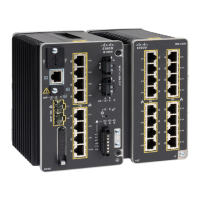32-23
Cisco IE 3000 Switch Software Configuration Guide
OL-13018-01
Chapter 32 Configuring QoS
Configuring Auto-QoS
Effects of Auto-QoS on the Configuration
When auto-QoS is enabled, the auto qos voip interface configuration command and the generated
configuration are added to the running configuration.
The switch applies the auto-QoS-generated commands as if the commands were entered from the CLI.
An existing user configuration can cause the application of the generated commands to fail or to be
overridden by the generated commands. These actions occur without warning. If all the generated
commands are successfully applied, any user-entered configuration that was not overridden remains in
the running configuration. Any user-entered configuration that was overridden can be retrieved by
reloading the switch without saving the current configuration to memory. If the generated commands fail
to be applied, the previous running configuration is restored.
Auto-QoS Configuration Guidelines
Before configuring auto-QoS, you should be aware of this information:
• AAuto-QoS configures the switch for VoIP with Cisco IP Phones on nonrouted and routed ports.
Auto-QoS also configures the switch for VoIP with devices running the Cisco SoftPhone
application.
Note When a device running Cisco SoftPhone is connected to a nonrouted or routed port, the
switch supports only one Cisco SoftPhone application per port.
• Auto-Qos VoIP uses the priority-queue interface configuration command for an egress interface.
You can also configure a policy-map and trust device on the same interface for Cisco IP phones.
• To take advantage of the auto-QoS defaults, you should enable auto-QoS before you configure other
QoS commands. If necessary, you can fine-tune the QoS configuration, but we recommend that you
do so only after the auto-QoS configuration is completed. For more information, see the
Effects of
Auto-QoS on the Configuration, page 32-23.
• After auto-QoS is enabled, do not modify a policy map or aggregate policer that includes AutoQoS
in its name. If you need to modify the policy map or aggregate policer, make a copy of it, and change
the copied policy map or policer. To use this new policy map instead of the generated one, remove
the generated policy map from the interface, and apply the new policy map to the interface.
• You can enable auto-QoS on static, dynamic-access, voice VLAN access, and trunk ports.
• By default, the CDP is enabled on all ports. For auto-QoS to function properly, do not disable the
CDP.
• When enabling auto-QoS with a Cisco IP Phone on a routed port, you must assign a static IP address
to the IP phone.
• This release supports only Cisco IP SoftPhone Version 1.3(3) or later.
• Connected devices must use Cisco Call Manager Version 4 or later.
